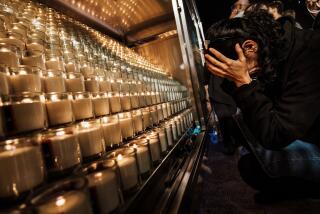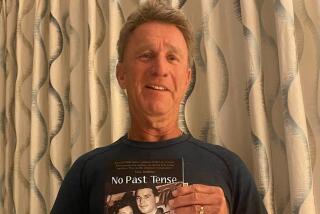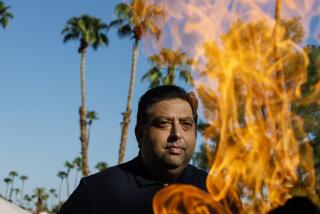‘BLUE NUMBERS’ FACTS, HOLOCAUST FACTS
- Share via
The Times’ review of Bruce Goldsmith’s “Blue Numbers” (Book Review, May 28) contained a number of apparent factual errors. In a letter to The Times, Goldsmith objects:
“I can understand people not responding to (“Blue Numbers”) favorably and even hating it, as your reviewer obviously did. But his attempt to support his dislike of my work by attacking specific details as factually inaccurate is in this instance not simply absurd but destructive.”
In what follows, a paragraph from Ronald Florence’s review (reprinted in italic) is divided into three parts, each of which is followed by citations or comments from Goldsmith.
The Holocaust is not terra incognita. To make a novel of Holocaust survivors (real or imagined) convincing, an author has to get his facts right. Sandy and his new love Paula’s parents are supposed to have been German Jews who were at Auschwitz. Auschwitz-Birkenau processed Jews from Eastern and Southeastern Europe, not German Jews.
Martin Gilbert, “The Holocaust” (Henry Holt & Co., 1985): “On July 15 the first two thousand deportees were sent from Holland to Auschwitz. Most of them were German Jews who had found refuge in Holland between 1933 and 1939.”
Sandy’s father is a German Jew who speaks with no trace of German, but the “cadence of his speech was distinctly Eastern European.” Goldsmith even tosses an occasional tochus or bubkes into the father’s speech for emphasis. It’s a nice touch, but German Jews do not speak Yiddish.
Goldsmith: “Some German Jews may not speak Yiddish, but a huge number do. If you’d like, I can bring some down to your office at the Times.”
Even the tattooed number is suspect. Jewish tattoos began with the letter “J” for Jude.
Primo Levi, “The Drowned and the Saved” (Summit Books, 1988): “The number of a Jew, starting in May 1944 (that is, with the mass arrival of Hungarian Jews) had to be preceded by an A, which shortly after was replaced by a B.”
Later in the review Florence writes:
(Paula’s) own parents are supposedly natives of Auschwitz, yet she never questions how this 32-year-old man (Sandy) could have been at the camp 40 years before she meets him.
Goldsmith comments:
“The story takes place during the summer of 1973. Sandy is described over and over again in the book as appearing to be 10 years older than his true age which is 32. This means Paula believes him to be 42. In Paula’s eyes, Sandy would have been born in 1931, making Sandy 13 years old in 1944 when he was supposed to have been in Auschwitz. I have a friend who was in Auschwitz at that age and that time, so I know it’s possible to survive.
“The last sentence of the review reads: ‘Let’s hope that the next time he does his homework first, gets his facts straight. . . .” I believe with the evidence I’ve supplied you can see that my facts have always been straight and that it’s your reviewer who’s wrong. The man spent fully one-third of the review attacking facts which were correct to begin with.”
--Editor Ronald Florence’s review bothered me, as it was full of petty, hostile and irrelevant comments. Florence missed the impact of Goldsmith’s main character being swept into a personal holocaust of his own, vividly set in contemporary Southern California. Please review the reviewer.
MARK RUBIN
LOS ALAMITOS
More to Read
The biggest entertainment stories
Get our big stories about Hollywood, film, television, music, arts, culture and more right in your inbox as soon as they publish.
You may occasionally receive promotional content from the Los Angeles Times.










